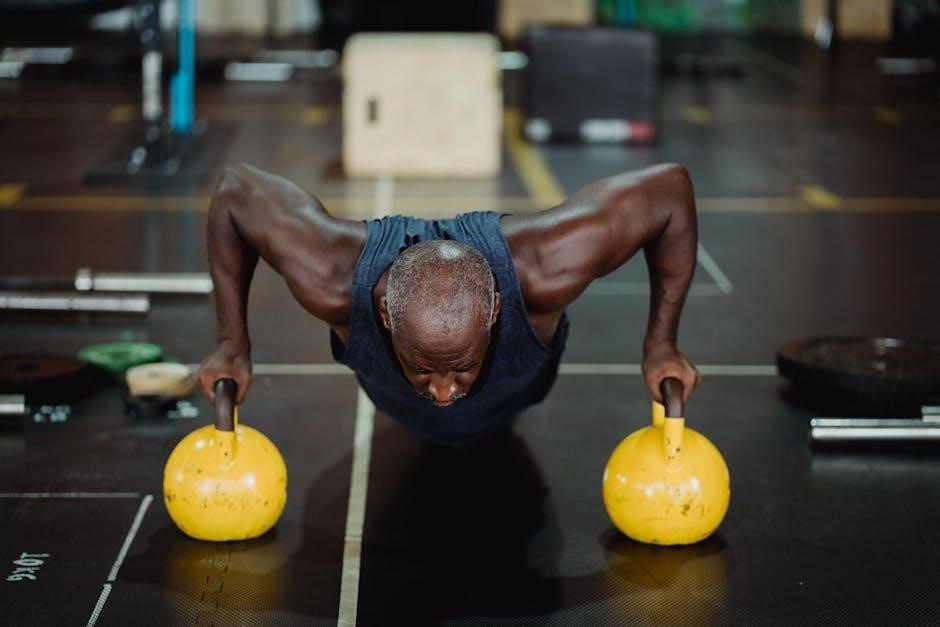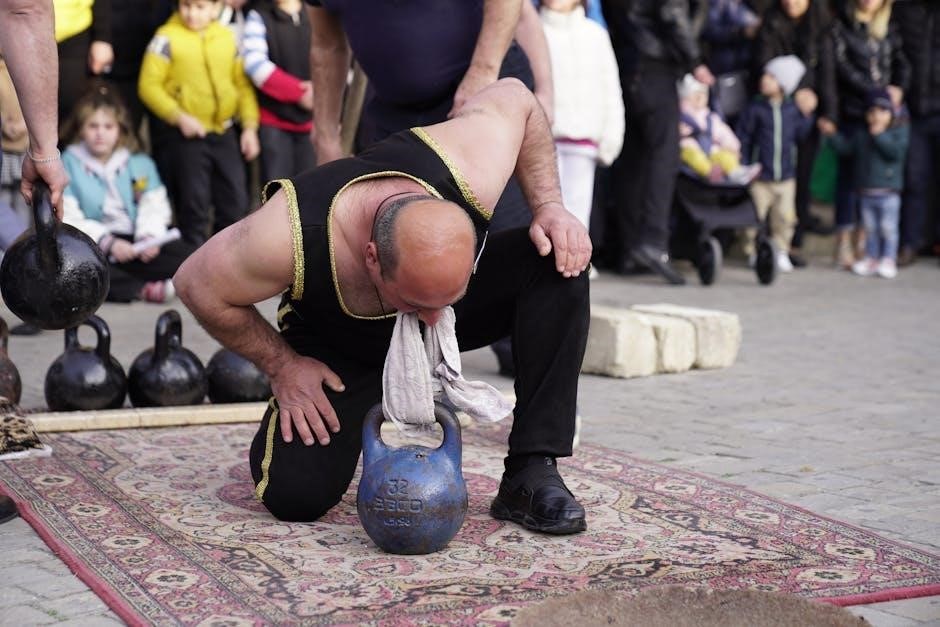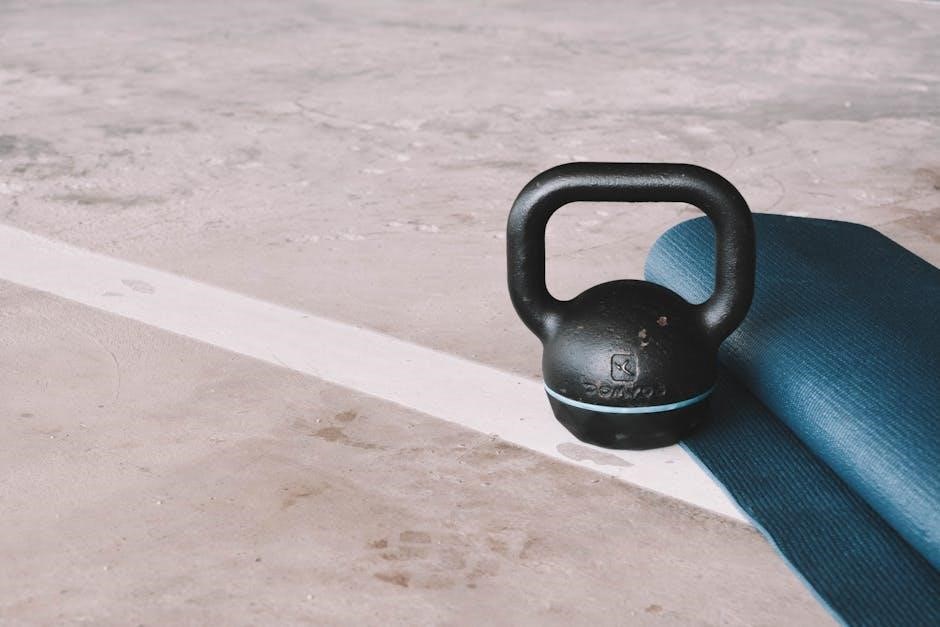Pavel Tsatsouline’s Enter the Kettlebell is a transformative guide offering a scientifically backed approach to kettlebell training‚ emphasizing full-body engagement and functional strength‚ ideal for all fitness levels.
Background of Pavel Tsatsouline
Pavel Tsatsouline‚ a renowned fitness expert‚ is credited with popularizing kettlebell training in the West. A former Soviet Union Special Forces instructor‚ he brings decades of experience in strength training and physical conditioning. Known for his no-nonsense‚ science-backed approach‚ Pavel founded StrongFirst‚ a globally recognized organization dedicated to strength development. His work‚ particularly Enter the Kettlebell‚ has revolutionized how people train‚ emphasizing functional strength and efficiency. Pavel’s methodologies are widely adopted by athletes‚ military personnel‚ and fitness enthusiasts‚ making him a pivotal figure in modern strength training.
Overview of the Book
Enter the Kettlebell by Pavel Tsatsouline is a comprehensive guide to mastering kettlebell training. The book introduces readers to the fundamentals of kettlebell exercises‚ focusing on foundational movements like the swing and Turkish get-up. It outlines a structured 5-week training program‚ progressively increasing in intensity. Emphasizing full-body engagement and functional strength‚ the book caters to both beginners and advanced trainees. Pavel’s expertise shines through as he breaks down complex techniques into simple‚ actionable steps. The text also covers essential principles like progressive overload and periodization‚ ensuring sustainable growth in strength and skill. Whether you’re aiming for general fitness or elite performance‚ Enter the Kettlebell provides a clear‚ science-backed path to achieving your goals.
Significance of Kettlebell Training
Kettlebell training is renowned for its efficiency in building strength‚ endurance‚ and coordination. Unlike traditional weights‚ its offset center of mass engages multiple muscle groups simultaneously‚ promoting full-body workouts. This method is particularly effective for improving functional strength‚ which translates to real-life activities and athletic performance. Kettlebell exercises‚ such as the swing and Turkish get-up‚ enhance power‚ mobility‚ and core stability. They also boost cardiovascular fitness‚ making kettlebell training a versatile option for conditioning. Its adaptability to various fitness levels and goals has made it a staple in military‚ sports‚ and rehabilitation contexts. The portability and cost-effectiveness of kettlebells further enhance their appeal‚ offering a practical solution for effective training anywhere.

Origins of Kettlebell Training
Kettlebell training‚ known as girya in Russia‚ traces back to the 18th century‚ originating among farmers and later adopted by the military and strongmen‚ evolving into a global fitness phenomenon.
History of Kettlebells
Kettlebells‚ known as girya in Russian‚ have a rich history dating back to 18th-century Russia‚ initially used by farmers as counterweights and by strongmen for demonstrations of strength. By the mid-19th century‚ they became a staple in Russian physical culture‚ incorporated into military training and competitive lifting events. The Soviet Union further popularized kettlebells‚ using them to build strength and endurance for soldiers and athletes. Pavel Tsatsouline’s work‚ including Enter the Kettlebell‚ introduced this ancient tool to the Western world‚ highlighting its versatility and effectiveness for full-body conditioning. The swing and Turkish get-up‚ foundational exercises in Tsatsouline’s system‚ emphasize dynamic movement and functional strength‚ making kettlebells a cornerstone of modern fitness training.
Kettlebell Training in the Soviet Union
In the Soviet Union‚ kettlebell training was integral to physical education and military preparation‚ fostering strength and resilience. The regime emphasized functional movements like the swing and clean‚ preparing citizens for labor and combat. Kettlebells were used in schools and military academies‚ with structured programs that prioritized progressive overload and full-body engagement. The Soviet approach‚ detailed in Enter the Kettlebell‚ focused on building a strong foundation‚ which later influenced modern kettlebell training worldwide. This systematic method ensured efficiency and durability‚ making kettlebells a cornerstone of Soviet physical culture and a lasting legacy in strength training.

Key Principles of Kettlebell Training
- Full-body engagement for efficient strength building.
- Functional movements mirroring real-life activities.
- Progressive overload to enhance strength over time.
Full-Body Engagement
Kettlebell training emphasizes full-body engagement‚ ensuring every exercise activates multiple muscle groups simultaneously. This holistic approach enhances strength‚ coordination‚ and endurance‚ making workouts efficient and effective. By integrating the entire body‚ kettlebell exercises like the swing and Turkish get-up improve functional fitness‚ mirroring real-life movements. This method reduces workout time while maximizing results‚ appealing to both beginners and advanced trainees. Pavel Tsatsouline highlights how full-body engagement fosters overall physical development‚ making kettlebell training a comprehensive fitness solution.
Functional Strength
Functional strength is a cornerstone of kettlebell training‚ focusing on building practical strength that translates to real-life movements and activities. Pavel Tsatsouline emphasizes that kettlebell exercises mimic natural human movements‚ enhancing coordination‚ balance‚ and power. This approach strengthens the body as a unified system‚ improving overall athleticism and resilience. By targeting compound movements like the swing and Turkish get-up‚ kettlebell training develops the ability to generate force and maintain control‚ making it invaluable for both everyday tasks and sports performance. Functional strength is not just about lifting weight but about mastering movement patterns that enhance overall physical capability and durability. This philosophy sets kettlebell training apart from isolated exercises‚ offering a more holistic approach to fitness.
Progressive Overload
Progressive overload is a key principle in kettlebell training‚ emphasizing the gradual increase of intensity to drive continuous improvement. Pavel Tsatsouline advocates for systematically increasing weight‚ reps‚ or difficulty over time to avoid plateaus and enhance strength. This method ensures that the body is consistently challenged‚ fostering adaptability and growth. By incrementally adding load or complexity to exercises like swings and cleans‚ trainees can build resilience and power; Progressive overload is not just about lifting heavier; it’s about mastering each step to create a strong foundation for advanced movements. This approach aligns with the Soviet training methods‚ where incremental progress was crucial for developing elite athletes. Through disciplined application‚ progressive overload maximizes the effectiveness of kettlebell training‚ leading to remarkable gains in strength and performance.

Basic Kettlebell Exercises
The Swing‚ Turkish Get-Up‚ and Clean are foundational kettlebell exercises that build strength‚ coordination‚ and endurance. These movements form the core of effective kettlebell training‚ promoting full-body engagement and functional fitness for all levels.
The Swing
The Swing is a foundational kettlebell exercise emphasized in Enter the Kettlebell; It involves hinging at the hips and generating power from the posterior chain. Pavel Tsatsouline highlights it as a cornerstone of kettlebell training‚ improving strength‚ endurance‚ and coordination. Variations include single-arm and towel swings‚ which enhance grip strength and control. The swing is often the first exercise taught‚ as it builds the necessary movement patterns for more complex lifts. It’s a simple yet effective movement that engages the entire body‚ making it a staple in kettlebell programs for all fitness levels‚ from beginners to advanced trainees.
The Turkish Get-Up
The Turkish Get-Up is a foundational exercise in Enter the Kettlebell‚ praised for its ability to build strength‚ mobility‚ and coordination. It involves transitioning from a lying position to standing while holding a kettlebell‚ engaging multiple muscle groups. Pavel Tsatsouline emphasizes its effectiveness for improving overall athleticism and stability. The exercise begins with rolling to the shoulder‚ transitioning to a lunge‚ and culminating in a standing position. Variations‚ such as the single-arm and weighted versions‚ add complexity. The Turkish Get-Up is a testament to kettlebell training’s focus on functional movement and full-body integration‚ making it a cornerstone of many kettlebell programs. It is particularly beneficial for enhancing core strength and joint mobility‚ ensuring a strong foundation for more advanced exercises.
The Clean
The Clean is a fundamental kettlebell exercise detailed in Enter the Kettlebell‚ focusing on explosive power and coordination. It involves lifting the kettlebell from the floor to the shoulders in a single‚ fluid motion. Pavel Tsatsouline highlights the importance of proper form‚ such as maintaining a neutral spine and using the hips for power. The Clean is a versatile exercise that enhances strength‚ speed‚ and endurance. It is often paired with presses or jerks and serves as a foundation for more complex movements. The Clean is a key component of many kettlebell programs‚ offering a full-body workout that targets the legs‚ core‚ and upper body‚ making it essential for building overall physical conditioning and functional strength.
Intermediate Kettlebell Exercises
Intermediate exercises in Enter the Kettlebell build on foundational movements‚ introducing complexity and intensity to enhance strength and coordination‚ preparing for advanced techniques seamlessly.
The Press
The kettlebell press is a fundamental intermediate exercise that targets the shoulders‚ triceps‚ and core. It involves pressing the kettlebell overhead from the racked position‚ ensuring proper form to prevent injury. Pavel emphasizes the importance of a tight core and full extension of the arm for maximum efficiency. The press is a progression from the clean and is essential for building overhead strength. It is often incorporated into training programs to enhance upper body power and stability. Proper technique‚ including a strong grip and controlled movement‚ is crucial for reaping the benefits of this exercise while minimizing the risk of injury.
The Snatch
The kettlebell snatch is an advanced exercise that combines power and technique‚ transitioning the kettlebell from a swing to an overhead position in one fluid motion. It is a cornerstone of kettlebell training‚ emphasizing explosive strength and coordination. Pavel highlights the snatch as a key exercise for building endurance and full-body integration. The movement requires precise timing and control‚ engaging the hips‚ legs‚ and arms harmoniously. Proper form is essential to avoid injury‚ with a focus on a deep backswing and smooth transition to the overhead lockout. The snatch is a critical component of intermediate and advanced training programs‚ offering unparalleled conditioning and strength benefits when performed correctly.

Advanced Kettlebell Exercises
Advanced kettlebell exercises‚ like the jerk and complex movements‚ challenge even the most experienced lifters‚ focusing on speed‚ precision‚ and full-body coordination for maximum strength and efficiency.
The Jerk
The jerk is an advanced kettlebell exercise that emphasizes explosive power and speed‚ involving a dynamic movement where the kettlebell is “caught” in an overhead position. It requires precise timing‚ strength‚ and coordination‚ making it a challenging yet rewarding exercise for experienced lifters. Proper form is critical to avoid injury‚ with a focus on hip drive‚ arm positioning‚ and controlled breathing. The jerk is often incorporated into complex routines to enhance overall athleticism and muscular endurance. Mastery of this movement demands consistent practice and attention to detail‚ as outlined in Pavel Tsatsouline’s detailed instructions in Enter the Kettlebell.
Complex Movements
Complex movements in kettlebell training involve combining multiple exercises into a single‚ fluid sequence‚ challenging the body in a highly efficient manner. These movements require coordination‚ strength‚ and focus‚ making them ideal for advanced practitioners. Pavel Tsatsouline emphasizes the importance of mastering basic exercises before progressing to complexes‚ as they demand precision and control. Examples include transitions between swings‚ cleans‚ and presses in one continuous flow. Complex movements enhance muscular endurance‚ improve coordination‚ and elevate cardiovascular intensity. They are a cornerstone of advanced kettlebell training‚ pushing the lifter to new levels of fitness and skill. These movements are thoroughly detailed in Enter the Kettlebell‚ providing a roadmap for safe and effective progression.

Kettlebell Training Programs
Enter the Kettlebell outlines structured training programs‚ including a 5-week plan with weekly progressions‚ designed to build strength‚ endurance‚ and overall fitness systematically.
5-Week Training Program
Pavel Tsatsouline’s Enter the Kettlebell includes a structured 5-week training program designed to progressively build strength and endurance. Each week introduces specific exercises with increasing intensity‚ starting with foundational movements like the swing and Turkish get-up. The program emphasizes proper form‚ consistency‚ and gradual overload to ensure safe and effective progress. By week 5‚ trainees are prepared for more advanced exercises‚ such as the clean and press‚ while maintaining a focus on full-body engagement. This systematic approach ensures that individuals of all fitness levels can follow the program‚ achieving measurable improvements in strength‚ endurance‚ and overall physical conditioning.
Weekly Progression
The 5-week training program in Enter the Kettlebell is structured to ensure steady progress through incremental increases in exercise intensity and volume. Each week builds on the previous one‚ introducing new challenges while reinforcing foundational movements. For example‚ Week 1 focuses on mastering the swing and Turkish get-up‚ while subsequent weeks gradually incorporate more complex exercises like the clean and press. The program emphasizes consistency and proper form‚ allowing trainees to adapt to the demands of kettlebell training safely. By following the weekly progression‚ individuals can achieve significant improvements in strength‚ endurance‚ and overall physical conditioning‚ preparing them for more advanced kettlebell exercises in the later stages of the program.
Sample Workout Routine
A sample workout routine from Enter the Kettlebell begins with a dynamic warm-up‚ including arm circles and leg swings. On Day 1‚ perform 3 sets of 10 swings and 3 sets of 1 Turkish get-up per side. Day 2 focuses on strength with 3 sets of 5 cleans and 3 sets of 3 presses. Day 3 is a rest day. Repeat this cycle‚ increasing reps weekly. Incorporate variations like single-arm swings and towel get-ups for diversity. Emphasize proper form and gradual progression to avoid injury. This routine balances intensity with recovery‚ aligning with Pavel’s philosophy of simplicity and consistency for effective kettlebell training.
Periodization
In Enter the Kettlebell‚ periodization is a structured approach to training‚ dividing workouts into phases to optimize progress and prevent overtraining. The program begins with foundational exercises like swings and Turkish get-ups‚ focusing on proper form and consistency. Each week introduces incremental challenges‚ such as increasing reps or transitioning to more complex movements like presses and snatches. Progressive overload is emphasized‚ ensuring gradual intensity increases. Recovery phases are integrated to allow adaptation and maintain training consistency. This systematic approach ensures athletes build strength and skill effectively‚ aligning with Pavel’s emphasis on simplicity and long-term development in kettlebell training.

Nutrition and Recovery
Nutrition and recovery are crucial for kettlebell training success. A balanced diet rich in protein‚ whole foods‚ and hydration supports muscle repair and energy replenishment‚ optimizing recovery and performance.
Diet for Kettlebell Training
A well-structured diet is essential for maximizing kettlebell training results. Emphasize protein-rich foods like lean meats‚ fish‚ and eggs to support muscle repair and growth. Include complex carbohydrates from whole grains‚ fruits‚ and vegetables for sustained energy. Healthy fats‚ such as avocados and nuts‚ are also vital for hormonal balance and recovery. Hydration is critical‚ with water intake recommended throughout the day. Avoid processed foods and sugars to maintain optimal performance. Pavel Tsatsouline’s approach in Enter the Kettlebell highlights the importance of fueling your body with nutrient-dense meals to enhance strength and endurance. Consistency in diet ensures better recovery and progress in kettlebell workouts‚ making it a cornerstone of a successful training program.

Recovery Techniques
Recovery is a crucial component of kettlebell training‚ as outlined in Enter the Kettlebell. Adequate rest‚ stretching‚ and mobility exercises help prevent injuries and enhance performance. Foam rolling and self-myofascial release are recommended to improve circulation and reduce muscle tension. Additionally‚ proper hydration and nutrition play a key role in recovery‚ with a focus on protein intake to repair muscles. Pavel Tsatsouline emphasizes the importance of active recovery‚ such as light cardio or yoga‚ to maintain mobility without overtaxing the body. Prioritizing sleep is also essential‚ as it allows the body to fully recover and adapt to the demands of training. Balancing recovery with intensity ensures sustained progress and long-term success in kettlebell workouts.

Safety and Injury Prevention
Proper form and warm-ups are essential to prevent injuries. Start with lighter weights and focus on controlled movements. Incorporate rest periods and stay hydrated to avoid overtraining.
Common Injuries
Common injuries in kettlebell training include lower back strain‚ shoulder impingement‚ and wrist pain. These often result from poor form‚ overtraining‚ or using excessive weight. The swing‚ snatch‚ and clean are exercises where improper technique can lead to injury. Back strain occurs when the lifter relies on momentum rather than hip power. Shoulder injuries are common in overhead presses and snatches due to improper tracking of the kettlebell. Wrist pain often arises from incorrect grip or failing to “hinge” properly. Prevention involves mastering form‚ starting with lighter weights‚ and incorporating regular warm-ups and cool-downs. Listening to your body and avoiding overtraining is crucial for long-term safety and progress in kettlebell training.
Proper Form
Proper form is essential for safe and effective kettlebell training. It begins with a strong stance‚ engaging the hips and core to generate power. The hinge movement‚ a cornerstone of kettlebell exercises‚ requires maintaining a neutral spine and bending at the hips‚ not the lower back. Gripping the kettlebell correctly ensures control‚ with a firm but not overly tight hold. During swings‚ the arms should remain straight‚ and the bell should “float” in the back position. For overhead presses‚ the kettlebell should track in line with the shoulder‚ avoiding any deviation. Proper form minimizes injury risk and maximizes strength gains. Consistent practice and attention to detail are key to mastering these techniques.

Comparison with Other Training Methods
Kettlebell training offers unique benefits‚ combining dynamic swings with strength work‚ unlike traditional dumbbells or barbells‚ providing full-body engagement and functional strength through its portable‚ versatile design.
Kettlebells vs. Dumbbells
Kettlebells and dumbbells are both effective strength-training tools but differ in design and functionality. Kettlebells have an offset center of mass‚ enabling dynamic‚ full-body movements like swings and cleans‚ which enhance power and coordination. In contrast‚ dumbbells are symmetric‚ making them ideal for isolated exercises such as curls and presses. Kettlebells require more engagement of stabilizer muscles‚ promoting functional strength‚ while dumbbells focus on specific muscle groups. The versatility of kettlebells allows for complex‚ compound movements‚ making workouts efficient and time-effective. For those seeking a combination of strength and conditioning‚ kettlebells offer a unique advantage over traditional dumbbell training.
Kettlebells vs. Barbells
Kettlebells and barbells are both versatile strength-training tools but cater to different training objectives. Barbells are optimal for heavy‚ precise lifts like squats and deadlifts‚ allowing for maximum weight loading and muscle development. Kettlebells‚ with their offset center of mass‚ excel in dynamic‚ functional movements such as swings‚ cleans‚ and snatches‚ which improve power‚ coordination‚ and endurance. While barbells focus on strength and hypertrophy‚ kettlebells emphasize full-body engagement and mobility. For athletes seeking a blend of strength‚ power‚ and conditioning‚ kettlebells offer a unique and efficient training alternative to traditional barbell exercises‚ making them a valuable addition to any fitness regimen.
Pavel Tsatsouline’s Enter the Kettlebell is a testament to the power of kettlebell training‚ offering a path to unparalleled strength‚ efficiency‚ and functional fitness for all levels.
Enter the Kettlebell by Pavel Tsatsouline is a comprehensive guide to kettlebell training‚ emphasizing full-body engagement and functional strength. It introduces foundational exercises like the swing and Turkish get-up‚ progressing to advanced movements such as the snatch and jerk. The book outlines a structured 5-week training program‚ focusing on progressive overload and proper form to maximize results while minimizing injury risk. Aimed at all fitness levels‚ it blends Soviet training principles with modern techniques‚ making it a timeless resource for achieving strength and endurance. The program’s clarity and effectiveness have made it a cornerstone of kettlebell training worldwide.
Final Thoughts
Enter the Kettlebell stands as a seminal work in strength training‚ offering a practical and efficient system for mastering kettlebell techniques. Pavel Tsatsouline’s expertise provides a clear path for beginners and seasoned athletes alike‚ ensuring sustainable progress and injury prevention. The integration of Soviet-era methods with modern insights creates a robust training framework. This guide not only transforms physical strength but also fosters mental discipline‚ making it an indispensable resource for anyone seeking a comprehensive fitness transformation. Its enduring popularity is a testament to its effectiveness and timeless principles‚ solidifying its place as a cornerstone of kettlebell training literature.
